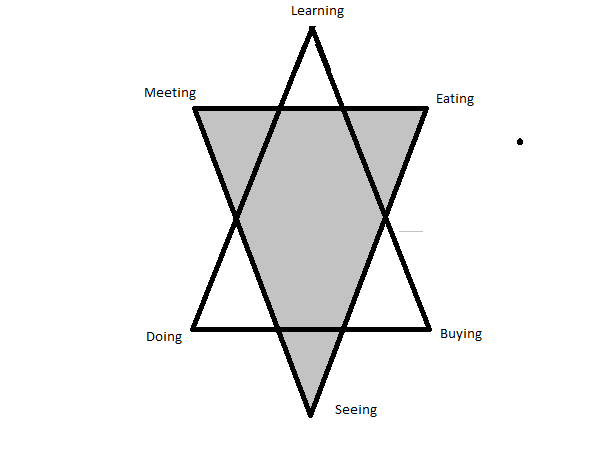Travis Smith took a tour around Singapore and concluded that everything about tourism revolved around six categories. These are:
- Learning something new
- Eating something new
- Seeing or watching something new
- Buying something new
- Physically doing something new
- Meeting someone or something new
He used the diagram below to describe these categories

Every tourism activity falls under the six categories, with every possible activity costing money. The extent to which one is satisfied is determined by the amount of money one is willing to spend (Smith, 2007). Giving examples with his experience, he described sailing on a boat in Mazatlan as “doing”, viewing Mazatlan from the air as “seeing something new”, and training to sail the boat as “learning something new”.
However, the experience does not have to be good. For instance, seeing something awful, disaster tourism, or even eating something icky, or meeting something weird is also very possible. Therefore, when determining who can travel well together, it is necessary to put the different tastes into consideration (Smith 2007). For instance, a combination of someone who likes hiking, with another one who likes shopping can turn out to be disastrous.
Hans Magnus Enzensberger also tried to come up with a provocative approach to understanding the theory of tourism (Gemunden 2007). He describes tourism as a manifestation of modern culture, right from the early tourists of the nineteenth century to the present age. In the mid-1950s, tourism was influenced by the food wave, sex wave and also the post-war recovery.
Beyond the late 1950s and during the second half of the 20th century, tourism was not only regarded as a social activity but as an economic activity as well. Travelers of the earlier days have changed to modern tourists (Tourism theories, 2010). This organization tries to explain what is expected of tourists in order to fulfill a role in sustainable development, it also describes a tourist not just as another client, but as a fully-fetched partner. In this aspect, the relationship is established between the destination and the tourist, and also the reflexive approach towards tourism.
Reference List
Gemunden, G 2007, Introduction to Enzenbergs: A Theory of Tourism, Berlin, s.n.
Smith, T 2007, A General Theory Of Tourism. Web.
Tourism theories, 2010. Web.